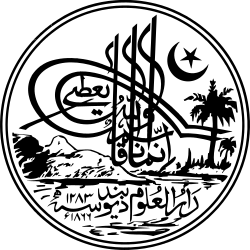Muhammad Yusuf Kandhlawi
Muhammad Yusuf Kandhlawi (1917-1965) was an Indian Islamic scholar who became the second ameer of the Tablighi Jamaat.[1]
Muhammad Yusuf Kandhlawi | |
|---|---|
| 2nd Amir of Tablighi Jamaat from 1944 to 1965 | |
| Preceded by | Muhammad Ilyas Kandhalwi |
| Succeeded by | Inamul Hasan Kandhlawi |
| Personal | |
| Born | 20 March 1917 |
| Died | 2 April 1965 |
| Religion | Islam |
| Era | 20th Century (modern era) |
| Denomination | Sunni |
| Jurisprudence | Hanafi |
| Movement | Deobandi |
| Main interest(s) | Basic principles and practices of Islam |
| Notable work(s) | Hayatus Sahabah, Muntakhab Ahadith, Six Points, Amani Al-Ahbar Fi Sharh Ma'ani Al-Athar |
| Alma mater | Mazahir Uloom Saharanpur |
| Occupation | Islamic scholar |
| Muslim leader | |
| Disciple of | Muhammad Ilyas Kandhlawi |
Influenced by
| |
| Part of a series on |
| Deobandism |
|---|
 |
| Ideology and influences |
| Founders and key figures |
|
| Notable institutions |
| Centres (markaz) of Tablighi Jamaat |
| Associated organizations |
Early life
He was born to a notable family of Sufi scholars and was exposed to an environment of piety at a young age. He memorized the Quran at the age of ten and continued to study Hadith and the Islamic sciences. He had a deep connection with the scholars of the time, and was himself recognized as one of the great Sufi scholars of the time. After his father, Muhammad Ilyas Kandhlawi died in 1944, he was appointed the 2nd Ameer of Tablighi Jamaat by the Shura (consultative body of religious leaders).
Bibliography
| Title | Description | Volumes | Language |
|---|---|---|---|
| Hayat Al-Sahabah | The Prophet's Companions' Way of Life | 3 | Arabic |
| Amani Al-Ahbar Fi Sharh Ma'ani Al-Athar | an annotation of a major work by Imam Ahmad Al-Tahawi | 4 | |
| Muntakhab Ahadith | Urdu/Arabic |
Family
maulana haroon kandlawi (son)
Wife (daughter of Muhammad Zakariyya al-Kandhlawi)
The paternal and maternal families of Muhammad Yusuf Kandhlawi come together in Hakim Muhammad Sharif Khan who was a physician from Uzbekistan.
He had migrated to India and was a physician to the Mughal emperors Shah Alam II (ruled 1759 – 1806) and possibly to his son Akbar II (ruled 1806 – 1837). These two families were residing in the villages of Kandhla and Jhinjhana in Uttar Pradesh, India.[2]
Hifz
As a young boy completed his primary education and studied Hadith, starting with the six main authentic collections, under the supervision of his father.
Hadith
He then undertook a more specialized study of Hadith under the distinguished scholars of Mazahir Uloom Saharanpur, a specialized school which placed particular emphasis on the study of Hadith, and trained its students in the art of Islamic advocacy. During his attendance at this school, he particularly benefited from studying under the supervision of Sheikh Muhammad Zakariya Kandhlawi, one of the top scholars of Hadith in the Muslim world in the twentieth century. He graduated from this school at the age of 20, in 1936 (1355 AH).[3]
Muhammad Yusuf memorized the Quran at the age of ten, from Hafiz Imam Khan Mewati. Syed Ahmad Faizabadi, the elder brother of Syed Husain Ahmad Madani, sent an honorary degree to Yusuf commemorating his memorization of the Quran.
Scholarly work
The first is Amani Al-Ahbar Fi Sharh Ma’ani Al-Athar, which is an annotation of a major work by Imam Ahmad ibn Muhammad al-Tahawi, a famous Egyptian scholar who lived much earlier. The book is in four large volumes.
It highlights the aspects related to Islamic propagation and advocacy. It thus reflects life at the time of Muhammad's companions, and shows their manners, feelings and thoughts in different situations. The book was published in Arabic in three volumes many times over by different publishers. More recently, it has been published, with annotation, in four large volumes, with two introductions by two highly reputable scholars, Syed Abul Hasan Ali Hasani Nadwi, and Sheikh Abd Al-Fattah Abu Ghuddah. [2]
Death
In 1965, Al-Kandhlawi made a long trip to former East Pakistan (Bangladesh) and West Pakistan (Pakistan), where he traveled throughout the country giving a long series of lectures and speeches. On the final day of his trip, he was scheduled to give a major speech in Lahore, and although he was too ill to give such a speech, he felt that he could not let people down. The speech took its toll on his health. On finishing the speech, he was immediately taken to a hospital. But he died on his way there, at the age of 48. His body was airlifted at night to Delhi, where his funeral was attended by at least two hundred thousand tablighi jamat saathi or Muslim mourners.[2] His funeral prayer was lead by Muhammad Zakariya Kandhlawi and was buried next to the grave of his father Muhammad Ilyas Kandhlawi.[4]
See also
- Tablighi Jamaat
- Muhammad Ilyas Kandhlawi
- Hayatus Sahabah
References
- Profile of Muhammad Yusuf Kandhlawi on wordpress.com website, Retrieved 7 May 2017
- Profile of Muhammad Yusuf Kandhlawi - Second Ameer (leader) of Tablighi Jamaat, Retrieved 8 May 2017
- Conversion Chart showing Islamic Calendar years converted to AD years on sites.google.com website, Retrieved 8 May 2017
- "Shaykh (Maulana) Muhammad Yusuf Kandhlawi (RA)". Central-Mosque.com. Retrieved 30 March 2020.